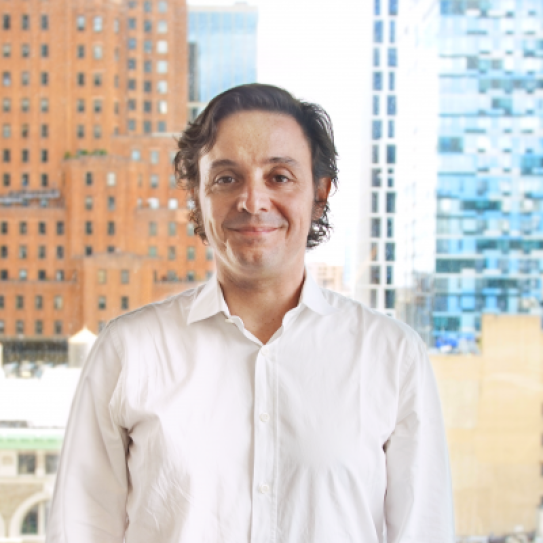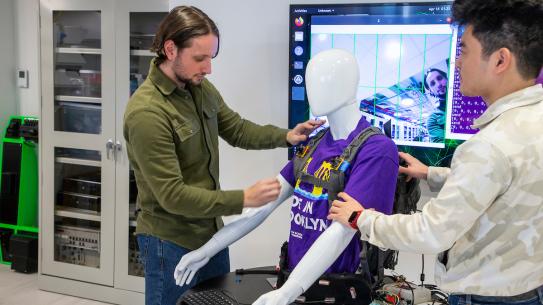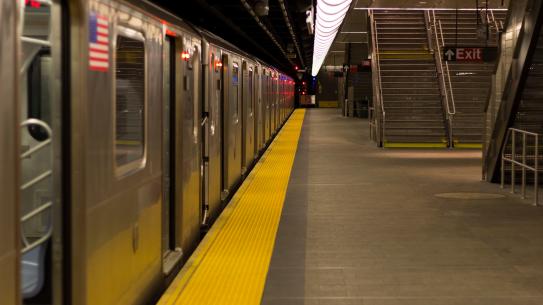Maurizio Porfiri
-
Institute Professor
-
Director of CUSP

Dr. Maurizio Porfiri is an Institute Professor at New York University Tandon School of Engineering, with tenured appointments at the Departments of Mechanical and Aerospace Engineering and Biomedical Engineering, and the Director of the Center for Urban Science and Progress of New York University. He received M.Sc. and Ph.D. degrees in Engineering Mechanics from Virginia Tech, in 2000 and 2006; a “Laurea” in Electrical Engineering (with honors) and a Ph.D. in Theoretical and Applied Mechanics from Sapienza University of Rome and the University of Toulon (dual degree program), in 2001 and 2005, respectively. He has been on the faculty of the Mechanical and Aerospace Engineering Department since 2006, when he founded the Dynamical Systems Laboratory.
Dr. Porfiri is a Fellow of the American Society of Mechanical Engineers (ASME) and the Institute of Electrical and Electronic Engineers (IEEE). He has served in the Editorial Board of ASME Journal of Dynamics systems, Measurements and Control, ASME Journal of Vibrations and Acoustics, Flow: Applications of Fluid Mechanics, IEEE Control Systems Letters, IEEE Transactions on Circuits and Systems I, IEEE Transactions on Network Science and Engineering, Mathematics in Engineering, and Mechatronics. Dr. Porfiri is engaged in conducting and supervising research on complex systems, with applications from mechanics to behavior, public health, and robotics.
He is the author of approximately 400 journal publications, including papers in Nature, Nature Human Behaviour, and Physical Review Letters. He was included in the “Brilliant 10” list of Popular Science in 2010 and his research featured in major media outlets, such as CNN, NPR, Scientific American, and Discovery Channel. Other significant recognitions include National Science Foundation CAREER award; invitations to the Frontiers of Engineering Symposium and the Japan-America Frontiers of Engineering Symposium organized by National Academy of Engineering; invitation to the third and fourth World Laureate Forums; the Outstanding Young Alumnus award by the college of Engineering of Virginia Tech; the ASME Gary Anderson Early Achievement Award; the ASME DSCD Young Investigator Award; the ASME C.D. Mote, Jr. Early Career Award; and the Research Excellence Award from New York University Tandon School of Engineering.
Education
Sapienza University of Rome, 2001
Laurea (B.Sc./M.Sc.), Electrical Engineering
Sapienza University of Rome, 2005
Doctor of Philosophy, Theoretical and Applied Mechanics
Virginia Polytechnic Institute & State University, 2000
Master of Science, Engineering Mechanics
University of Toulon, 2005
Doctor of Philosophy, Theoretical and Applied Mechanics
Virginia Polytechnic Institute & State University, 2006
Doctor of Philosophy, Engineering Mechanics
Experience
NYU Tandon School of Engineering
Institute Professor
From: January 2020 to present
NYU Tandon School of Engineering
Professor
From: September 2014 to present
NYU Tandon School of Engineering
Associate Professor
From: September 2011 to August 2014
NYU Tandon School of Engineering
Assistant Professor
From: July 2006 to September 2011
Virginia Polytechnic Institute and State University
Post-Doctoral Associate
From: July 2005 to June 2006
Publications
Journal Articles (selection from the last ten years)
- Porfiri, M., 2020: "Validity and limitations of the detection matrix to determine hidden units and network size from perceptible dynamics", Physical Review Letters 124(16), 168301
- Porfiri, M., Sattanapalle, R. R., Nakayama, S., Macinko, J., Sipahi, R., 2019: "Media coverage and firearm acquisition in the aftermath of a mass shooting", Nature Human Behaviour 3(9), 913-921
- Zhang, P., Rosen, M., Peterson, S. D., Porfiri, M., 2018: "An information-theoretic approach to study fluid-structure interactions",Journal of Fluid Mechanics 848, 968-986
- Golovneva, O., Jeter, R., Belykh, I., Porfiri, M., 2017: "Windows of opportunity for synchronization in stochastically coupled maps",Physica D: Nonlinear Phenomena 340, 1-13
- Zino, L., Rizzo, A., Porfiri, M., 2016: "Continuous-time discrete-distribution theory for activity-driven networks", Physical Review Letters 117(22), 228302
- Mwaffo, V., Anderson, R. P., Butail, S., Porfiri, M., 2015: "A jump persistent turning walker to model zebrafish locomotion", Journal of the Royal Society Interface 12(102), 20140884
- Cha, Y., Porfiri, M., 2014: "Mechanics and electrochemistry of ionic polymer metal composites", Journal of the Mechanics and Physics of Solids 71, 156–178
- Panciroli, R., Porfiri, M., 2013: "Evaluation of the pressure field on a rigid body entering a quiescent fluid through particle image velocimetry", Experiments in Fluids 54(12), 1630
- Marras, S., Porfiri, M., 2012: "Fish and robots swimming together: attraction towards the robot demands biomimetic locomotion", Journal of the Royal Society Interface 9(73), 1856–1868
- Abaid, N., Porfiri, M., 2011: "Consensus over numerosity-constrained random networks", IEEE Transactions on Automatic Control 56(3), 649-654
- Aureli, M., Kopman, V., Porfiri, M., 2010: "Free-locomotion of underwater vehicles actuated by ionic polymer metal composites",IEEE/ASME Transactions on Mechatronics 15(4), 603-614
Awards
- Institute Professor at NYU Tandon School of Engineering, 2020
- ASME Fellow, 2019
- IEEE Fellow, Control Systems Society, 2019 ("For contributions to biomimetic robotics")
- ASME C.D. Mote, Jr. Early Career Award, 2015
- Invitee of Japan-America Frontiers of Engineering Symposium, National Academy of Engineering, 2014
- Jacobs Excellence in Education Award, 2014
- ASME Dynamic Systems & Control Division Young Investigator Award, 2013
- ASME Gary Anderson Early Achievement Award, 2013
- Outstanding Young Alumnus, College of Engineering Virginia Polytechnic Institute and State University, 2012
- Best student paper competition award at the 2012 ASME Conference on Smart Materials, Adaptive Structures and Intelligent Systems (with graduate students Youngsu Cha and Matteo Aureli)
- Invited speaker for the “lectio magistralis” at “Sapienza Ricerca”, 2011
- Best paper award at the 2011 ASME Dynamic Systems and Control Conference (with graduate student Nicole Abaid)
- Invitee of Frontiers of Engineering Symposium, National Academy of Engineering, 2011
- Jacobs Excellence in Education Award, 2011
- Popular Science "Brilliant Ten", 2010
- Best robotics paper award at the 2009 ASME Dynamic Systems and Control Conference (with graduate students Matteo Aureli and Vladislav Kopman)
- NSF Career award (Dynamical systems), 2008
- H2CU medal, 2008
Research News
Asylum seekers’ mental health benefits from sheltering in refugee centers, new study reveals
Sheltering in refugee centers can positively impact asylum seekers’ mental health, according to a new study published in Communications Medicine, underscoring the benefits of providing migrants safe and welcoming transitional environments in which professionals in the host countries monitor their psychological and physical needs.
The study’s multidisciplinary research team, coordinated by Emanuele Caroppo — Head of International Projects and Researches at the Department of Mental Health Asl Roma 2 — administered a battery of six questionnaires, ranging from demographic surveys to comprehensive psychological assessments, to a cohort of 100 asylum-seekers in 14-day COVID-19-related quarantines in Italy between August 2020 and September 2021.
Maurizio Porfiri, NYU Tandon Institute Professor and Director of the Center for Urban Science and Progress (CUSP), designed the framework for the statistical analysis and led the interpretation of the results. He and Pietro De Lellis, associate professor in the Department of Electrical Engineering and Information Technology at University of Naples Federico II, are the corresponding authors on the paper.
The study’s aim was to understand the impact of the first contact with the reception system on the mental health of asylum-seekers, and to delve into predictors of Post Traumatic Stress Disorder (PTSD) among that population.
Twenty-three percent of asylum-seekers in the study had PTSD — higher than the 4 to 10% incidence previously reported among the general global population. Pre-migration traumatic experiences were the key influencers in the the development of PTSD, including the infliction of bodily injury and torture, and witnessing violence. The study found no specific demographic factors that played a crucial role in predicting PTSD. Social ties and education levels did not emerge as salient features to predict the onset of PTSD.
Despite the incidence of PTSD, the authors also observed that a 14-day stay in reception facilities appeared to positively impact asylum-seekers’ mental health, with the proportion of participants needing to undergo further psychological assessments decreasing from 51% to 21% throughout the quarantine period.
The study offers a significant step towards understanding the relationship between migration, mental health, and the reception environment. Asylum-seekers, who have already endured tremendous hardship, may find a glimmer of hope in the notion that a supportive and secure environment can significantly contribute to their psychological well-being.
Along with Porfiri, De Lellis and Caroppo, the study’s researchers are Carmela Calabrese, Department of Electrical Engineering and Information Technology, University of Naples Federico II and the Institut de Neurosciences des Systèmes (INS), Aix Marseille Université; Marianna Mazza, Institute of Psychiatry and Psychology, Department of Geriatrics, Neuroscience and Orthopedics, Fondazione Policlinico Universitario A. Gemelli IRCCS and Università Cattolica del Sacro Cuore, Department of Psychiatry, Università Cattolica del Sacro Cuore; Alessandro Rinaldi, Migrant Health Unit, Local Health Authority Roma; Daniele Coluzzi, Migrant Health Unit, Local Health Authority Roma; Pierangela Napoli, Migrant Health Unit, Local Health Authority Roma; Martina Sapienza, Department of Life Sciences and Public Health, Università Cattolica del Sacro Cuore; and the UOC Salute Mentale Asl Roma 2 in Rome, Italy.
Caroppo, E., Calabrese, C., Mazza, M. et al. Migrants’ mental health recovery in Italian reception facilities. Commun Med 3, 162 (2023)
Spiropyran-functionalized photochromic nylon webbings for long-term ultraviolet light sensing
This research was performed under the direction of Maurizio Porfiri, Institute Professor of Mechanical and Aerospace Engineering, Biomedical Engineering, Civil and Urban Engineering and incoming Director of the NYU Center for Urban Science and Progress (CUSP) at NYU Tandon. Collaborators were Peng Zhang, former researcher in Porfiri’s group and now faculty member at Tennessee Tech, and John Ohanian, research scientist at Luna Innovations.
Webbing structures — from chin straps and parachute material, to space habitats — are extensively employed in engineering systems as load-bearing components. They are frequently subjected to extended ultraviolet (UV) light irradiation, which can affect their integrity and reduce their mechanical strength. Despite technological advancements in structural health monitoring, long-term UV sensing techniques for webbings remain under-developed.
In the study, "Spiropyran-functionalized photochromic nylon webbings for long-term ultraviolet light sensing," published as the lead research (and featured cover) in the Journal of Applied Physics, the investigators explored an enticing solution: a photochromic nylon webbing that, because it comprises spiropyran (SP) functionalized polymers, demonstrates color variation in response to extended UV exposure with controlled, color variation over multiple time scales that is conducive to UV sensing.
The team developed a mathematical model grounded in photochemistry to interpret experimental observations, unveiling the photochromic phenomenon as a multi-step, multi-timescale photochemical process involving several chemical species offering the basis for the inference of the webbing’s color
In their research, the team found that the decay rate of the webbings’ color demonstrated a dependence on the initial concentration of the SP dye. Webbings with the lowest dye concentration maintained sensitivity for four weeks, whereas at the highest dye concentration, they exhibited sensing capability after eight weeks. Thus dye concentration could be customized to meet the lifetime of the targeted applications.
The proposed photochromic webbing and the photochemistry-based mathematical model could inform future designs of UV-sensitive structures that maintain sensitivity under weeks of continuous sunlight UV exposure.
Hydrodynamic model of fish orientation in a channel flow
This research was led by Maurizio Porfiri, Institute Professor of mechanical and aerospace engineering, civil and urban engineering, and biomedical, and a member of the Center for Urban Science and Progress (CUSP) at NYU Tandon. Co-authors are Post-Doctoral Associate Peng Zhang of the department of mechanical and aerospace engineering at NYU Tandon and CUSP, and Sean D. Peterson of the University of Waterloo.
For over a century, scientists have sought to understand how fish orient against an incoming flow, even without visual and flow cues. In this study the researchers explore a potential hydrodynamic mechanism of fish rheotaxis — movement away or toward water currents — through the study of the bidirectional coupling between fish and the surrounding fluid.
The researchers point out that a major contribution of the proposed model is the treatment of the fish as an invasive sensor that both reacts to and influences the background flow, thereby establishing a coupled interaction between the fish and the surrounding environment.
By modeling a fish as a vortex dipole, a jet flow with a system of two vortices, in an infinite channel with an imposed background flow, they established a dynamical system that captures the existence of a critical flow speed for fish to successfully orient while performing cross-stream, periodic sweeping movements.
The researcher's juxtaposed their models with experimental observations in the literature on the rheotactic behavior of fish deprived of visual and lateral line cues. The crucial role of bidirectional hydrodynamic interactions unveiled by this model points at an overlooked limitation of existing experimental paradigms to study rheotaxis in the laboratory.
Solvation-Driven Electrochemical Actuation
In a new study led by Institute Professor Maurizio Porfiri at NYU Tandon, researchers showed a novel principle of actuation — to transform electrical energy into motion. This actuation mechanism is based on solvation, the interaction between solute and solvent molecules in a solution. This phenomenon is particular important in water, as its molecules are polar: oxygen attracts electrons more than hydrogen, such that oxygen has a slightly negative charge and hydrogen a slightly positive one. Thus, water molecules are attracted by charged ions in solution, forming shells around them. This microscopic phenomenon plays a critical role in the properties of solutions and in essential biological processes such as protein folding, but prior to this study there was no evidence of potential macroscopic mechanical consequences of solvation.
The group of researchers, which also included Alain Boldini, a Ph.D. candidate in the Department of Mechanical and Aerospace Engineering at NYU Tandon, and Dr. Youngsu Cha of the Korea Institute of Science and Technology, proposed that solvation could be exploited to produce macroscopic deformations in materials. To this end, Porfiri and his group utilized ionomer membranes, unique polymeric materials in which negative charges cannot move. Positive ions can easily enter these membranes, while negative ions are repulsed by them. To demonstrate actuation, ionomer membranes were immersed in a solution of water and salt, between two electrodes. Applying a voltage across the electrodes caused the membrane to bend. The paper, "Solvation-Driven Electrochemical Actuation," is published in the American Physical Society's Physical Review Letters.
According to the model developed by Porfiri and his group, the voltage caused a current of positive ions toward the negative electrode. These ions entered the membrane from one side, along with the water molecules in their solvation shells. On the other side of the membrane, positive ions and their solvation shells were dragged outside. The membrane responded like a sponge: the side full of water expanded, while the side with less water shrank. This differential swelling produced the macroscopic bending of the membrane. Studying actuation with different ions helps understand this phenomenon, as different ions attract a different number of water molecules around them.
The discovery of macroscopic mechanical consequences of solvation paves the way for more research on membranes. The group expects applications in the field of electrochemical cells (batteries, fuel cells, and electrolyzers), which often rely on the membranes utilized in this study. These membranes also share similarities with natural membranes, such as cell membranes, on which the mechanical effects of solvation are largely unknown.
The work was supported by the National Science Foundation under grant No. OISE-1545857 and the National Research Foundation of Korea (NRF) funded by the Korea government (MSIT) under grant No. 2020R1A2C2005252.






